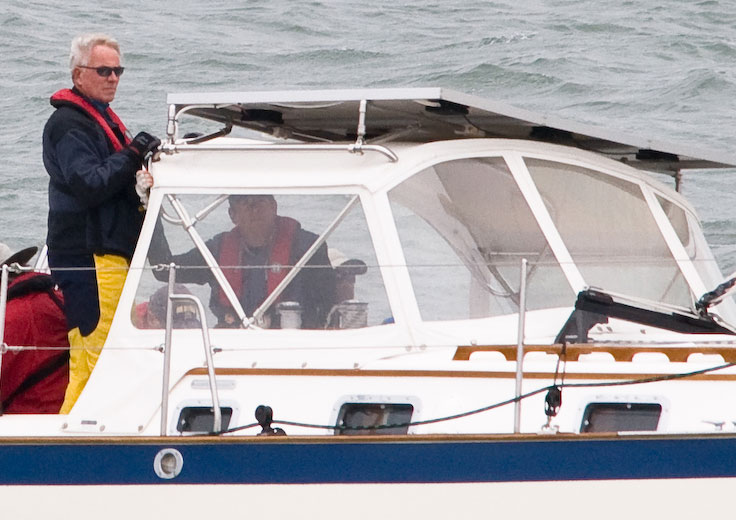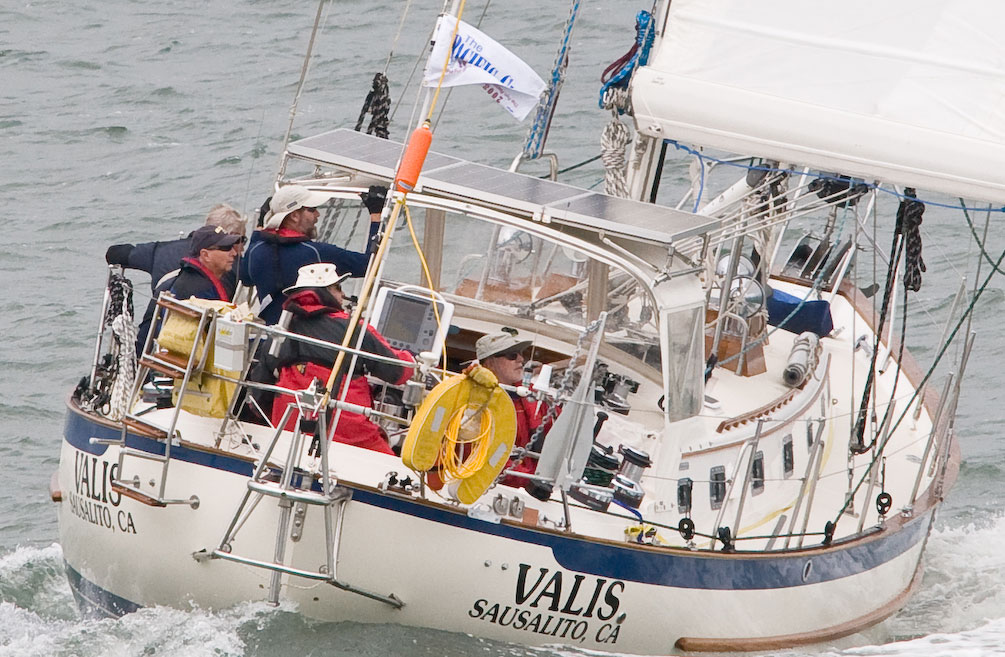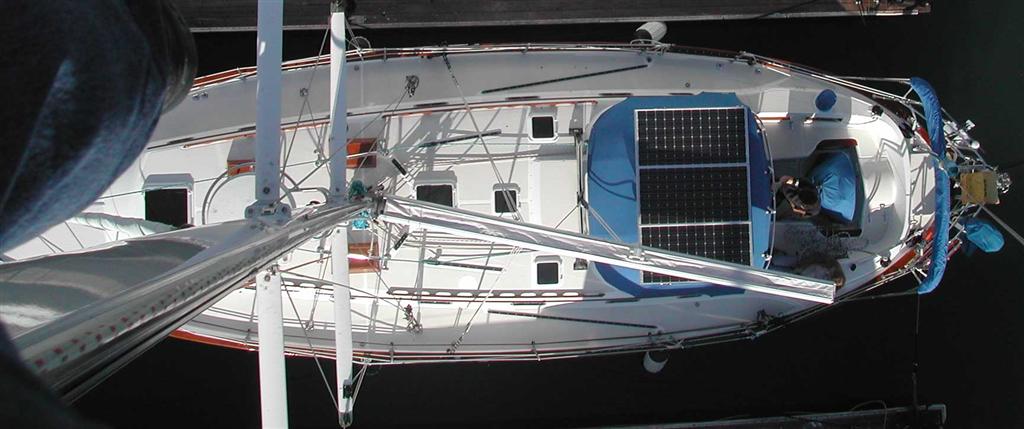


Flexible and Low-Profile
Solar Panels
An interim report
I'm considering putting a hard dodger on VALIS to replace the existing canvas one, and as part of the exercise I'm looking at solar panel options. I currently have three 100W panels from Shell Solar / BP that are attached to a stainless tube framework on top of the dodger. This works well, but the overall height is excessive and the exposed corners worry me. Nobody has been injured on them during our three Hawaii voyages, but why press my luck?.
Here are some photos of the current design:
 |
 |
 |
I would like to reduce the dodger height slightly (although not by a lot as the bridge deck is as high as the cockpit coaming). It can't extend much further forward because of the mid-boom mainsheet.
Here is a list of low-profile marine-grade (I hope!) solar panels that I have found. Some of these are semi-flexible, which may make it easier to attach them to the dodger.
Vendor |
Model |
Power W |
Length mm |
Width mm |
Height mm |
Weight Kg |
Price |
W/Msq |
$/W |
Notes |
URL |
| SunWare | SW-3064 | 36 | 638 | 456 | 5 | 3.1 | 123 | 21 Vmp, 3% Flex, Aluminum plate, 40 cells / string | http://www.sunware.de/index.php?id=19&L=1 | ||
| SunWare | SW-5065 | 48 | 780 | 460 | 5 | 4.0 | $1025 | 134 | $21.35 | 18 Vmp, 3% Flex, Aluminum plate, 39 cells / string | http://www.e-marine-inc.com/products/solar_panels/sunware.html |
| SunWare | SW-5066 | 69 | 890 | 600 | 5 | 5.4 | $1266 | 129 | $18.33 | 18 Vmp, 3% Flex, Aluminum plate, 39 cells / string | |
| IQ Solar | 82 | 840 | 680 | 8 | 3.7 | $850 | 144 | $10.37 | 10.1 Vmp, Rigid, Aluminum back, 20 cells / string (need 2 in series for typical controller) | http://www.iqsolar.com/pages/IQSolar2010.pdf | |
| IQ Solar | 30 | 550 | 440 | 6 | 124 | 6 Vmp, Rigid, Aluminum back, 12 cells / string | prototype | ||||
| ModuSolar | 40 | 840 | 390 | 4 | 2.6 | $500 | 122 | $12.50 | 10% Flex, Carbon/Kevlar backing | http://www.modusolar.eu http://www.minitransat650.com/simple/index.php?action=printpage;topic=2285.0 |
|
| ModuSolar | 80 | $960 | $12.00 | 10% Flex, Carbon/Kevlar backing | |||||||
| GB-Sol | Flexi-70 | 70 | 800 | 700 | 14 | 3 | 125 | 18.4 Vmp, 0.25% Flex, 36 cells | http://www.gb-sol.co.uk/images/products/gbsol-flexi-70.pdf | ||
| Kyocera | KC130TM | 130 | 1425 | 653 | 38 | 13 | $470 | 139 | $3.62 | Rigid | A typical home-solar panel |
For comparison, I have included a typical "home energy" style solar panel, designed for rooftop mounting. You will notice the huge price/Watt difference between the high-volume panels and the ones optimized for sailboat mounting. While some of this difference is no doubt due to the "Boat-Buck" multiplier, I believe that the low volumes and high level of customization and customer support account for most of the premium. These prices are as delivered to the USA, and may not include any additional taxes or fees. Of course the proces are a moving target, but this should still provide useful numbers for comparison.
The "W/Msq" (Watts per square meter) is a measure of panel efficiency and this uses the full area of the panel, not just the area that is covered with cells. This means that panels such as the IQ-Solar and Kyocera which have the electrical junction box on the backside of the panel, and have the front side more-fully covered with cells, will show better than some of the flex panels that have to use some of the surface area for connectors. The efficiency of the cells themselves may very well be identical.
"Vmp" is the (typical) Voltage a panel puts out when loaded to its Maximum Power Point. A "MPPT" (Maximum Power Point) charge-controller will operate the panel at this point and convert the output to match the requiements of the battery being charged. You will usually get a 10% or so improvent in charging current with an MPPT controller.
How do I choose a panel for my dodger? I still need to look at any reliability data I can find, which will probably be in the form of reports from users. I need to look at the form-factor, to see how many panels I can fit on the dodger. For example, it might be possible to fit six of the IQ-Solar 82W panels, but I need to see if this will extend too far into the cockpit. If these will fit, that would 492 Watts would be a big improvement over my present 300W. I would need a new charge-controller, since my Blue Sky unit is only good for 300W.
I had originally starting looking for flexible panels, and these are a very good solution for mounting on the deck surface, but my needs may be met with a low-profile rigid design. The output of a solar panel is reduced by heat, so having a rigid panel on short standoffs to allow some ventilation might provide a performance advantage over a glued-down panel. I have to say that I'm leaning towards the IQ-Solar product, in part because they are located in nearby Washington State, and I've spoken with Chris (the owner) who seems to know his stuff. But, I've still got a lot of work to do before making a final decision.
Note: The top of the dodger is arguably the worst place I could have chosen to put my solar panels. Here, they are shaded by the boom, the shrouds, the mainsail, and the mast. A well-placed shadow can completely shut down a solar panel. Other boats have placed the panels on a stern arch, on the bimini, on the foredeck, and on brackets attached to the stanchions. In spite of this, I have chosen the dodger. The advantages are aesthetic, and that the panels are out of the way. In my energy-budget calculations I assume that on the average I am getting 2/3 of the potential outpt, and the other 1/3rd is lost to shading. This has proved to be a reasonable estimate. Of course cloud cover can have a huge impact on panel output, so one must be prepared for that as well.